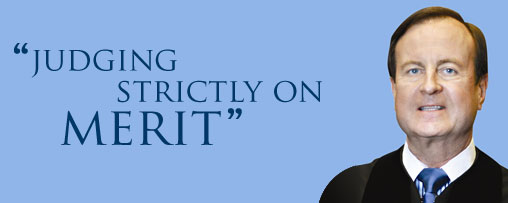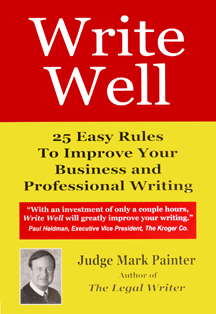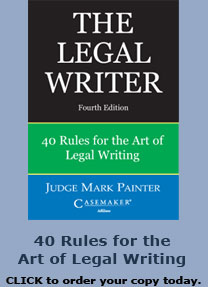The Legal Writer #22 –A Publisher’s Blunder
By Judge Mark P. Painter
Last column noted Lynn Truss’s book Eats Shoots and Leaves: A Zero Tolerance Approach to Punctuation. I said that it would soon be available in the states. You might ask: why the delay —couldn’t they have imported some copies here and sell them right away? Well, I thought the reason was that much of the punctuation would be wrong here. Remember, in the U.S., periods and commas always go inside quotation marks. In England, they only sometimes do. It was jarring for me to read a book about punctuation that seemed mispunctuated. But of course it was correct for across the pond. So I assumed the book was to be “Americanized” and reprinted. But no.
Penguin chose not to conform the book to American punctuation. For a book that purports to teach Americans accurate punctuation to be replete with incorrect punctuation is an abomination. In a note to readers, Penguin maintains that a change to American style would be “misguided,” which is as absurd as it is slothful. The American edition should have conformed to American usage. Penguin did not respond to two emails seeking comment. Unfortunately, I cannot recommend the American version of the book.
More Punctuation Problems
As an appellate judge, I read thousands of attorneys’ briefs. And I peruse cases by dead and live judges. Punctuation mistakes abound. The most common: misplacing commas and periods in quotations. Lawyers use too many quotations, but that’s a different issue. As noted above, here commas and periods always go inside quotation marks. Lawyers mess it up about half the time.
Another problem is the serial comma. Omitting it can be deadly. “Chickens, ducks, and geese” is clear. “Chickens, ducks and geese” allows someone — a lawyer or judge — to assert that “ducks and geese” are a distinct category. Or consider “Smith ordered bacon, eggs and cheese.” Did Smith want eggs mixed with cheese? Writing “Smith ordered bacon, eggs, and cheese” clears up the ambiguity.
In one case, the “rule of the serial comma” was debated page after page by majority and dissenting opinions.i The problem was that a recreational-immunity statute defined “property” as “real property and buildings, structures and improvements thereon, and the waters of the state.” Is that three categories, two, or just one? Should it be (1) real property along with any structures and improvements thereon, and (2) waters; or (1) real property, (2) any structures and improvements on the real property, and (3) waters. It mattered because the plaintiff was suing the owner of a tree stand (structure) who didn’t own the real estate. If the immunity statute applied, the owner of the stand was immune. In a 2-1 decision, the Wisconsin Supreme Court ruled that the statute created three categories. The dissent, relying on the lack of the comma after “real property,” said that the statute was ambiguous.
Using the serial comma never creates ambiguity; leaving it out sometimes does.
Another case might have turned on whether there was a comma or a semicolon. Federal law made it a crime “to ship or transport in interstate or foreign commerce, or possess in or affecting commerce, any firearm or ammunition; or to receive any firearm or ammunition which has been shipped or transported in interstate or foreign commerce.”
The federal court observed, “Oddly, Congress did not use the locution ‘in interstate or foreign commerce’ when it came to criminalize possession, but merely referred to ‘in or affecting commerce’.” Of course, the court itself misplaced the quotation marks, so its credibility in interpreting punctuation was immediately suspect. The court then went on to confound its error by stating, “The use of the semicolon, rather than a comma, suggests the end of a clause or a completed thought, rather than a pause in an enumeration of related ideas.”ii That’s true as far as it goes, but another use for a semicolon is to separate listed items that themselves contain commas.
Hundreds of legal cases are decided by punctuation, or more likely mispunctuation. My favorite is a Washington State case where the rule of the last antecedent was pitted against the distinction between that and which, together with the comma-versus-semicolon argument. All in one sentence!
The sentence in question, which was itself an exception to a preceding sentence: “PROVIDED, That nothing contained in this definition shall be construed to include or apply to any institute, bona fide club, or place of accommodation, which is by its nature distinctly private, including fraternal organizations, though where public use is permitted that use shall be covered by this chapter; nor shall anything contained in this definition apply to any educational facility, columbarium, crematory, mausoleum, or cemetery operated or maintained by a bona fide religious or sectarian institution….” (Emphasis added.)
The issue was whether the public accommodation law applied to fraternal organizations, in this case, the Fraternal Order of Eagles. Does the law apply only to the organizations mentioned before the words distinctly private, or does it also apply to fraternal organizations, which comes after? Did the legislature mean that fraternal organizations were distinctly private by definition? Or does the which denote a nonrestrictive clause, which provides supplemental, nondefining information? If so, that would mean that fraternal organizations was just an example. One side pointed to the two semicolons, alleging that the semicolon separating the two parts meant that there were two categories: (1) fraternal and (2) religious.
Not surprisingly, the court held that the statute was ambiguous.
And earlier this year, an injunction against gay marriages was denied by a judge based on a semicolon. The Proposition 22 Legal Defense and Education Fund had asked the court to order the City of San Francisco to “cease and desist issuing marriage licenses to and/or solemnizing marriages of same-sex couples; to show cause before this court.” But there should have been an or where the semicolon was. The judge said, “The way you’ve written this. . . I don’t have the authority to issue it under these circumstances. . . . I am not trying to be petty here, but it is a big deal. That semicolon is a big deal.”
Lawyers, and everyone else, should not have to rely on interpretations — or misinterpretations — of punctuation rules. Laws are being written, cases won or lost based on the placement of a comma or semicolon. Let’s strive to write documents that can be understood — documents that don’t have to be interpreted. Who knows what our society might look like if we all knew how to punctuate properly?
Readability
Each column, I list the two major readability statistics — remember, you can program Word to tell you these and more. Statistics for this column: 15 words per sentence, 5 percent passive voice. (Remember the 1818 Rule — no more than an average of 18 words per sentence and 18 percent passive voice sentences.iii).
Endnotes:
i Peterson v. Midwest Sec. Ins. Co. (Wisc. 2001), 636 N.W.2d 727.
ii United States v. Coward (2001), 151 F. Supp. 2d 544, 547.
iii See, Painter, The Legal Writer 2nd Ed.: 40 Rules for the Art of Legal Writing (2003), 61-72.
![]()
____________________________________
Mark Painter is a judge on the Ohio First District Court of Appeals and an Adjunct Professor at the University of Cincinnati College of Law. He is the author of five books, including The Legal Writer 2nd ed.: 40 Rules for the Art of Legal Writing. The book is available at Joseph-Beth Booksellers in Cincinnati and Cleveland, The Book Loft in Columbus, the Ohio Book Store in Cincinnati, Barnes & Noble in Cincinnati (Kenwood), and from Ohio Lawyers Weekly Books at http://books.lawyersweekly.com. Judge Painter has given dozens of seminars on legal writing. Contact him at jugpainter@aol.com, or through his website at www.judgepainter.org.








